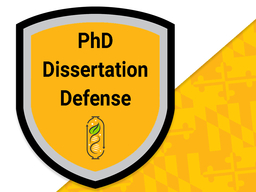PhD Dissertation Defense: Mandar Bokare
Location
Online
PhD Dissertation Defense: Mandar Bokare – Online Event
Date & Time
May 23, 2022, 1:00 pm – 2:00 pm
Description
Location : WEBEX only
Mandar Bokare, PhD Candidate
Advisor: Dr. Upal Ghosh
Application of Passive Sampling to Improve Quantitative Assessment of Fate, Transport, and Bioaccumulation of Hydrophobic Organic Contaminants in an Urban Watershed
Abstract:
Chemical activity of hydrophobic organic contaminants (HOCs) such as polychlorinated biphenyls (PCBs), polycyclic aromatic hydrocarbons (PAHs), and organochlorine pesticides (OCPs) governs the fate and transport in the environment and is the thermodynamic driver for uptake into aquatic organisms. Quantification of chemical activity is thus critical for assessing bioaccumulation, fate, and transport, and for identifying appropriate remedial actions at contaminated sites. The freely dissolved concentration (Cfree) of HOCs is directly related to chemical activity and can be measured accurately by passive sampling. However, use of Cfree measurements in conventional regulatory context has been limited due to lack of precedent. The conventional regulatory framework typically focuses on sediments as the main source of HOCs to the water body and to aquatic organisms. This can often lead to incomplete or even erroneous understanding of important fate and transport processes and over-estimation of effectiveness of sediment remediation strategies.
The present study complemented an ongoing remedial investigation at a contaminated urban river and demonstrates the use passive sampling-based measurements in various environmental media for addressing important data gaps about the fate and transport of these HOCs. Quantification of diffusive exchange of HOCs across the air-water interface showed the atmosphere to be a sink for PCBs and OCPs, while for PAHs, the role of the atmosphere varied between source, sink, and the equilibrium depending upon the seasons. Cfree measurements led to identification of a single tributary and sediment hot-spots having the most negative impact on the river. Finally, Cfree measurements were used to develop and validate food web PCB bioaccumulation and fate and transport models. Linking these models enabled quantitative assessment of impacts of multiple remediation strategies on PCB bioaccumulation in fish. Results indicate a combination of source control from a polluted tributary and focused sediment remediation to be the most effective strategy for the river.
Overall, this research presents a framework in which passive sampling-based measurements of Cfree can be integrated with conventional regulatory mechanisms to quantitively address the fate, transport, and bioaccumulation of HOCs, potentially leading to improved remedial decisions for reducing ecological and human health risks at contaminated sites.
Agneda
12:45 PM EST - Virtual WEBEX room opens
1:00 PM EST - Presentation followed by questions from the audience.
After the questions from the public, the meeting will be closed for the committee discussion.
WEBEX Information:
use the 'Join Online Event' button above
Join by phone
+1-202-860-2110 United States Toll (Washington D.C.)
Access code: 2623 985 4738
TAP TO JOIN FROM A MOBILE DEVICE (US Toll free)
18446213956,,26239854738##
Tags:
